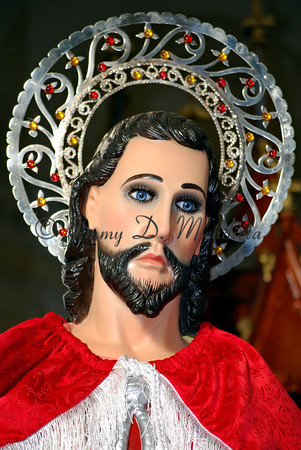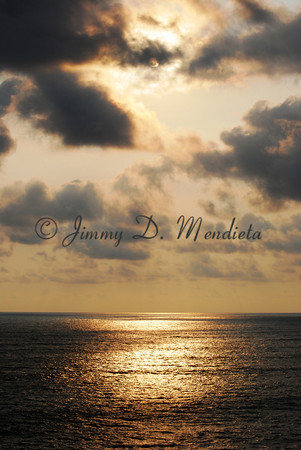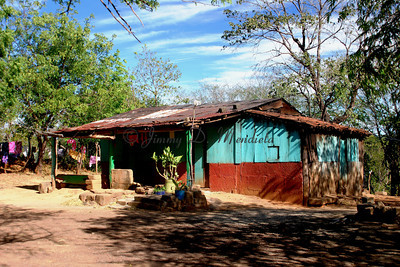Author: Dr. Armando Luna Silva
Photography by: Jimmy Mendieta
Translation by: Claudia Vallejos/Jeffrey Mendieta

Copyright 2012 Jimmy Mendieta. All rights reserved.“This is the image of Santiago that by the streets of the Jinotepen July strolls its wondering gaze of marine horizon, searching in the neighborhood’s and street corners what he there did not lose: a green bell of algae, like born from the sea, with a twang like a marimba that only knows how to cry. It’s a prodigious image of strength and tenderness; its face is the loneliness, the space, the distance, it’s the prow that survives in the clarity of the waters”. Dr. Armando Luna Silva
Amidst the Nicaraguan land, Jinotepe rises. This noble city is a bundle of friendship and cleanliness. Against its skyline, the towers of the Parish Church rise like a Titan’s arms that guard the image of the Apostle Santiago, Patron Saint of the city. Friar Pedro Agustín Morel de Santa Cruz visited Jinotepe in 1751. In his visit report he describes the people and its Church, and while addressing the people he says: “Santiago is entrusted to you”.
At the start of the century, the good people of the town of Jinotepe felt a nocturnal passion for the stories of apparitions, hauntings and penitent souls. Its dusk was frightful. Lax and unhurried. The shadows came slowly and it was then when ghosts would gain added mobility. In the closed nights of never ending rain, when the ghosts invaded the crevices of the town and the superstitious lighting traversed through the street, the elderly maid of the home would gather the children near the fire burning stove to tell them terrifying tales. And before the astonished gaze of the children and their suspense filled breaths paraded “la carretanagua”, “la cegua”, “la lutuda”, “el cadejo”,…
Very close to Jinotepe, in the Pacific Ocean, you can find the beaches of Huehuete. It’s a sea in which you hear the whispering language that only fisherman and lovers understand, and from whose waters escape the celestial color that bathe its coasts. It’s a sea of memories of family and friends, with a taste of tamarind, turtle eggs and milk that flows down from the farms to bathe the dawn in paleness and hunger for adventure.
A legend says that in front of those beaches traveled a Spanish galleon whose name, colors and age were lost over time. In front of the beaches of the Pacific, the second mate, an ambitious man, throws overboard the honor of the sailor threshing a mutiny, intending to seize the treasures of the galleon. The ambition of gold is intoxicating. The flashing of the dagger and the sound of the harquebus destroys bodies that roll covered in blood. There is a tragic tune of pain and death that breaks the wind that comes from the sea. Suddenly the waves lifted threatening their hands of foam against the ship as if it was claws that want to rip out of it a valuable treasure. The eternal conquering sea was a cruel whip. It is in danger of being shipwrecked. The galleon, prey of the tormenting sea is thrown in one and another direction, with the sails destroyed and the masts mutilated by the violence of the waves. The crew is dragged to the dark depths of the ocean. The desperate rebel gives orders to throw out to sea any load to reduce weight. In the hold of the ship stood out two large boxes. The crew follows the order and throws the boxes into the sea. The ferocious waters take possession of them, and upon contact the sea recovers its normal rhythm. The remains of the galleon continues sailing and the surviving crew contemplates with astonishment the marvel before them. The two boxes float gently, as if without weight, resembling chests of nacre, led by hands of angels and like this, slipping over the blue, they come to a rocky point of the beach of Huehuete.

Beach of Huehuete. Copyright 2012 Jimmy Mendieta. All rights reserved. “The tide, with the tenderness of a lullaby, rises until it places the boxes next to the so called “Zanja de Ambar”. – Dr. Armando Luna Silva
The tide, with the tenderness of a lullaby, rises until it places the boxes next to the so called “ Zanja de Ambar” (Ditch of Amber). It leaves them there, commended to a messy carpet of rocks which are caresed by the waves. Two salters (men that exploit the salt in the beaches of Carazo) walk by the beach. Curiously they approach the chests wihile the shivers creep up thru their wet pants. With a solemnity that crushes the anxiousness, they open one of them. Big surprise! They discover a statue of the Apostle Santiago. They try to remove the statue from the chest and it slips from their hands. They attempt to take a gold bell that hangs from the neck of the Apostle, but the bell slips from their fingers and sinks in the “Zanja de Ambar”. The wind descends from above the ditch that never ends and ripped the vibrations from the bell that began to lull as it fell amongst walls of amber, of salt and of myths that time creates.
That bell is the one referenced in the verse that the Diablo Mayor recites in its dances:
From the infernos I have come
to fulfill a promise.
Yes! Yes! Yes!
To fulfill a promise
for a bell that the sea
from the Patron Santiago wanted to steal.
The “Zanja de Ambar”, is an immense crack opened in the rock that makes fearsome the ebb of the tides. For the natives it was a sacred place. In it they would throw offerings to the god of the ocean.
The two salters with respectful fear shut the box. A halo of light is released from them as if in their interior they carried stars, and a flock of seagulls weaves the white pallium that flutters against in the air with a gentle sound and full of wings that grow upon the sand. The salters, with the a whisper of “Jesus protect us” clinging to their lips, run in search of help to transport the boxes to the nearest church.
The nearest place to seek help is “La Loma de Bartolo” (The Hill of Bartolo). The hill is a solid rock formation that rises next to the “Zanja de Ambar”. In the middle ages it would have been the ideal spot to build a castle. Its owner was a person with ample economic resources, very loved and respected in the region. As one who loves stories of apparitions, he listens attentively to his two visitors. Then, he doubts between keeping the boxes and facilitating their transfer; however, he authorizes the salters to find in the field two oxen to yoke to a wagon in order to transport the images.
While the salters search for the oxen, the man from the hill sent several workers so that they would take over the boxes and bring them up to his home. Those sent arrive at the ditch. They attempt to take the boxes, but they rise up into the air while they watched in fear asand the boxes position themselves above the highest rocks. They make one more attempt. It turns out to be impossible to take possession of them because they acquired an extraordinary weight. It would be said that they became bound to the rock. The workers think this is the doing of an enchantment. The fear grows in their eyes, and some run away to tell the boss what happened and others stay behind contemplating the boxes with a captivated gaze.
The salters enter the fields. The oxen of the Hill have a reputation of being unfriendly and of running away at the tiniest movement of the lasso of the camper. That day they did not run away, they strolled slowly to meet with their visitors. They lower their nape gently to be yoked to the wagon and they set out on their way down to the “Zanja de Ambar”. The workers that stare in fascination at the boxes, informed the salters of the extraordinary weight and of the enchantment that surrounds them. The salters take them in their arms and find them very light. The Witch of Huehuete would recount that a legion of angels lifted them in their arms. The boxes are placed on the wagon and they go up by the Hill of Bartola. The man of the Hill, because of so many miracles, is certain that in the unopened box is another image. Because of this, he offers to take charge of both images and raise an altar in the Hill so they are revered in front of the sea. The salters think it’s God’s will that the images be kept at the churches, and the wagon descends the hill and takes the road that leads to the city of Diriamba.
While marching thru the plain, the hills and the fords, the rhythm of the wagon is harmonizing with the symphony of the earth and the sky, and with the beat of screeching wheels and nature, true and fake anecdotes begin flowing; dull religious hymns and drowsy tunes common in the countryside spring up. Like this, talking and singing they get through the distance and smells of the fields and of the villages.

Copyright 2012 Jimmy Mendieta. All rights reserved. Country house, Casares, Carazo, Nicaragua. Surely the country houses from back then were not too different to this one.
The men of the salt stop at a diner on the road and divulge the miraculous discovery. The peasants, making the sign of the cross with one hand and their hat in the palm their other hand approach to see and touch the boxes. The wagon continues, up and down the hills, and the salters are coated in dust . As they continue on their way they swell in honor, and they are overwhelmed with joy because they feel chosen by the Lord. They feel unique in the world because the son of Thunder, like a downpour, fills their heart.
The wagon enters Diriamba by the “Quebrada del Perro” (Ravine of the Dog). The main street leads them to the church. They try to unload one of the boxes but it once again becomes impossible to carry. It has recovered the extraordinary weight that the workers from the “Loma de Bartola” had told them about. They try the other one. It is light. It seems intent to get off-loaded from the wagon; it’s like a beating heart. They guide it to the inside of the church. They open it. There is Saint Sebastian who has chosen, by a divine plan, the city of Diriamba to be its beloved Patron.
The salters return to the wagon. The oxenonce again start the march without any direction . This time they head towards Jinotepe. The rays of the sun fall like arrows of fire on the road. The elders from the area say that the road seemed like a clutter of stars and the coffee plantation from the shore bloomed at the pass of the wagon, turning the blooms into a white and trembling hymn of purity. The wagon arrives at the Parochial Church of Jinotepe. It stops in front of it. The salters dubiously test the load of the box. It is light again. They climbed the stairs of the Temple. In their throats are prayers and fatigue causes their legs to ache. They open the box. They lift the image of Santiago and the entire city is covered with the magnitude of a new and brilliant star.
This is the image of Santiago that by the streets of the Jinotepen July strolls its wondering gaze of marine horizon, searching in the neighborhood’s and street corners what he there did not lose: a green bell of algae, like born from the sea, with a twang like a marimba that only knows how to cry. It’s a prodigious image of strength and tenderness; its face is the loneliness, the space, the distance, it’s the prow that survives in the clarity of the waters.
The old maids of the village tell that the image of Santiago is an image sculpted by the waves of the ocean with gloves of clouds and blue inspiration. And they say, that a virtuous person that gazes into the “Zanja de Ambar”, sees the bell and hears the same ding-dong that guides he whom is lost in the mountain near the sea and prays to Santiago for protection. It’s because of this that they claim that the bell will be retrieved when flesh and forgiveness shed over the arms of Nicaragua peace, forgiveness and love.
This tale was taken from the book “El Patrón Santiago” written by Dr. Armando Luna Silva, beloved son of the city of Jinotepe; lawyer, diplomat and writer. In a conversation that we had with Dr. Luna he gave us his consent to publish this captivating and passionate story.
Our sincerest thanks to Dr. Armando Luna Silva!

